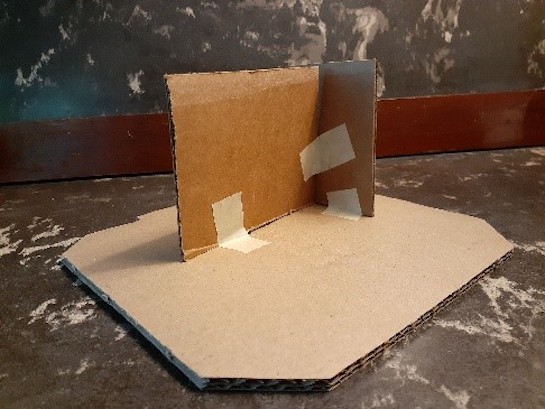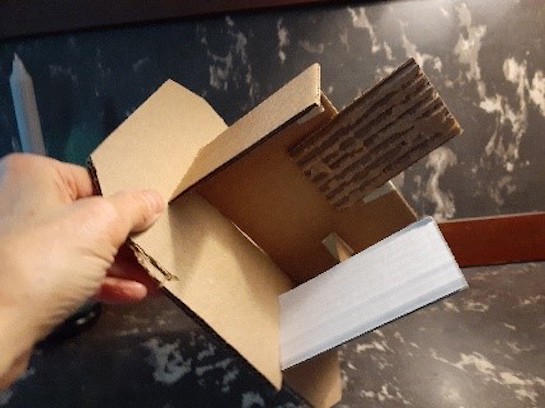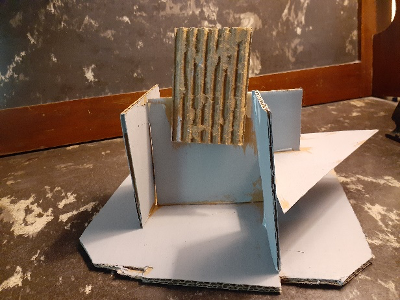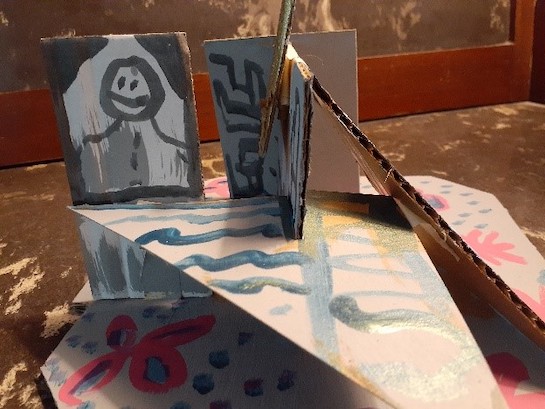Students will build a sturdy Cubist sculpture using recycled materials. Recommended for 5th Graders.
Form: a 3-dimensional figure that exists in space instead of flat on paper. This lesson uses geometric forms, instead of natural or organic.
Shape: is two-dimensional (flat), limited to height and width. A two-dimensional (flat) area enclosed by a line. This lesson uses geometric shapes: symmetrical, straight edged.
Texture: actual texture is how something feels when touched; visual texture (also called simulated texture) is how something appears to feel.
Asymmetrical Balance: a form or shape in which neither side is the same as the other but they still make a whole, with equally important sides.
Contrast: A technique that shows differences in the elements of visual arts in an artwork. In this lesson it is heart against the complimentary-colored background.
Focal Point: the part of an artwork that is emphasized in some way and attracts the eye and attention of the viewer; also called the center of interest.
Movement: How the artist makes the viewer’s eye move around the composition.
Unity: the connecting of parts of a work of art, creating a feeling of peace and a sense of completeness. All parts should work together. Not enough unity is chaotic to the viewer, while too much unity is boring.
Abstract: an artwork that uses color, line, shape or form to create a composition which may or may not have any visual reference to the world.
Composition: using principles of design to arrange elements of art to create art; the way elements are combined to express a particular idea.
Cubism: a style of painting and sculpture developed in the early 20th century characterized by a reduction of natural forms to their geometrical equivalents. Also, planes of a represented object aren’t always where they would be in nature. Created principally by Pablo Picasso and Georges Braque.
Details: Smaller things that inform the information conveyed.
Sculptors make sculpture.
Sculpture: the art of making 3-dimensional forms.
Sculpture is made by sculptors in many different ways. They can carve or chisel, as in wood or stone, by modeling, as in clay, casting, as in metal and assembling, or building by adding pieces together in a unified, interesting composition. It can represent something from life or not. This lesson is about assembling a sculpture using found objects in a meaningful way.
Developed in the early 20th century by Picasso, Braque and other cutting-edge artists, Cubist sculpture freed them to strive for new ways to represent the human experience. It’s no accident that abstract art gained popularity soon after the advances of photography took over the job of representing real life accurately and innovation in ways to see the world was now enticing a new generation. Cubism was originally considered ‘scandalous’ because it didn’t represent reality, but eventually triggered an avalanche of experimentation and new, visually interesting styles.

Students will:




Lesson written by Cynthia Moring.
21st Century Thinking Skills
Thinking flexibly, persisting, creating, innovating, taking responsible risks, reflecting, observing, making connections sequencing, problem solving, decision making, analyzing.
WA State Learning Standards
(VA:Cr2.1.5) a. Experiment and develop skills in multiple art-making techniques and approaches through practice.
(VA:Cr2.2.5) a. Demonstrate quality craftsmanship through care for and use of materials, tools, and equipment.
(VA:Cr2.3.5) a. Identify, describe, and visually document places and/or objects of personal significance. This happens if students bringing personal objects.
(VA:Cr3.1.5) a. Create artist statements using art vocabulary to describe personal choices in art-making. This happens if students write or verbalize about their art.
(VA:Cn10.1.5) a. Apply formal and conceptual vocabularies of art and design to view surroundings in new ways through art making.
Arts Integration Opportunities
Procedural writing: describe the process of making the sculpture.
Narrative writing: describe the sculpture as a place and write about an encounter that happens there.
Please note: These lesson plans are intended for non-profit use only. Use of these plans for commercial purposes should give attribution to the Issaquah Schools Foundation and be accompanied by a nominal donation at www.isfdn.org/donate. Thank you.
Fueling Success for Every Student, Every School